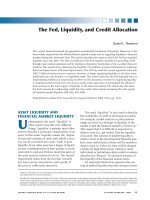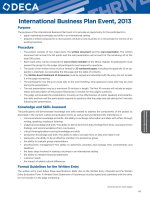The.1-2-3.Money.Plan.Oct.2010_13 pdf
Bạn đang xem bản rút gọn của tài liệu. Xem và tải ngay bản đầy đủ của tài liệu tại đây (327.45 KB, 21 trang )
ptg
the phrase “the best thing since sliced bread?” Target-
date retirement funds, at least the good ones, give sliced
bread a run for its money. This is a one-stop-shop
investment, a set-it-and-forget-it tool for retirement
money, whether you’re still working or already in retire-
ment. Pick a year you’ll probably retire, say 2030, and
put all your retirement money into a 2030 target-date
fund. Then you’re on autopilot. Most employers nowa-
days offer these target-date options in 401(k) plans,
and, of course, almost any mutual fund investment—
including target-date funds—are an option in a self-
directed retirement plan, such as an IRA or Roth IRA.
Everybody should know the basics of retirement
planning, so following is the shortest primer on retire-
ment allocations you’ll ever see. But I contend that it
suffices for most people.
● Spread your money around. Divvy up your money
among major asset classes, typically U.S. stocks,
foreign stocks, and bonds. Stocks, which refer to
investing in private companies, are the higher-
risk/higher-reward portion of your retirement
bundle. Bonds are the safer portion. If one asset
class grows quicker than the others, you have to
“rebalance”—shift money around in your invest-
ments—to get them back in line with your tar-
geted allocations.
● Adjust your portfolio over time. When you’re
younger, you can afford to take more risk because
you have time to wait out any prolonged down-
turn in the market. Therefore, portfolios for
younger people have a greater portion of stocks
and less of bonds. Conversely, as you approach
234
The 1-2-3 Money Plan
From the Library of Wow! eBook
ptg
retirement or after you retire, you can’t afford to
take as much risk because you’ll need the money
soon. That’s why you want more bonds and less
stocks.
That brings us to target-date funds. Target funds
do both of those things—diversify and rebalance—
automatically.
How do you choose a good target-date fund? If
you’re in an employer-sponsored retirement plan, you
probably only have one brand of target-date funds, so
go with it. If you’re choosing among all investments—
in an IRA or Roth IRA, for example—choose one from
one of these three companies:
● Vanguard, www.vanguard.com
● T. Rowe Price, www.troweprice.com
● Fidelity, www.fidelity.com
Of course, other companies offer good target-date
funds too, but I’m here to make things easier. And these
three companies offer excellent choices in target-date
funds.
If you want a nudge in a specific direction for open-
ing a new account, check out Vanguard. It has the low-
est built-in expenses, which is a good thing and
arguably, over the long haul, the most important thing.
If you have the minimum $3,000 to open an account,
put all of it, including future contributions, in the
Vanguard Target Retirement fund with a year closest to
when you’ll retire. It will have a name like Vanguard
Target Retirement 2030.
235
How to Save Money
From the Library of Wow! eBook
ptg
What If Your Employer Doesn’t Offer a
Target-Date Fund?
If your 401(k) or other employer plan does not offer a
target-date fund, retirement investing gets considerably
more complicated. Get started by putting 60 percent in
a broad stock index fund, such as a “total stock” index
or “S&P 500” index. Put 20 percent in a foreign-stock
index fund, and 20 percent in a bond index fund. But
that’s a generic and conservative allocation. You’ll want
to tweak that to fit your age and risk tolerance. One
broad rule of thumb is to subtract your age from 120.
That’s the percentage of your retirement money that
should be invested in stocks. The rest goes in bonds.
So a 40-year-old would have 80 percent overall in
stocks (60 percent U.S. stocks, 20 percent foreign) and
236
The 1-2-3 Money Plan
QUICK TIP: TWEAKING TARGET-DATE FUNDS
What if you want to take more risk than the average
person with your retirement portfolio, or less risk?
Simply choose a different target-date fund. If you
want to take on more risk for the opportunity to get
larger returns, choose a target-date fund with a date
that’s further away. It will have a higher portion in
stocks. If you want less risk, choose a nearer target
date. Don’t know if you’re a risk-taker? Take a quiz
developed at Rutgers University, at http://njaes.
rutgers.edu/money/riskquiz/. How freaked out did
you get in 2008 when the stock market tanked?
That’s a very accurate measure of your risk tolerance.
From the Library of Wow! eBook
ptg
20 percent in bonds. If you’re conservative, your stock-
allocation percentage might be 100 minus your age.
You’ll have to rebalance the allocations yourself,
which again, refers to shifting money out of good-per-
forming investments and putting the money into poorer
performing ones. That’s counterintuitive. But when you
rebalance, you’re essentially selling high and buying
low, the most basic and best investing strategy.
Rebalance at least once a year—on your birthday, for
example—or when investment allocations get out of
line by, say, 2 percent.
237
How to Save Money
Why Index Funds?
An index mutual fund holds investments, such
as stocks, that simply mimic an established
index, such as the Standard & Poor’s 500 Index.
Index funds don’t go searching for undervalued
stocks ready to take off. In fact, index funds are
dull and boring. And, oh yeah, they’re superior
to most funds you’ll ever buy. Over time, index
funds beat two-thirds to three-quarters of
actively managed funds.
How can that be? It’s because almost nobody,
including the most brilliant minds on Wall
Street, can consistently pick winning stocks over
the long term. If some succeed over a short
time, it’s just as likely to be dumb luck as bril-
liance. Index funds are cheaper to operate
because they don’t have to pay for a big-salary
stock picker. And they incur less tax costs
From the Library of Wow! eBook
ptg
238
The 1-2-3 Money Plan
because they trade less than actively managed
funds. Therefore, more of the gains from the
fund are passed along to you, the investor.
If you’re going to invest in mutual funds,
whether inside a retirement account or outside,
choose index funds. In fact, the target-date
retirement funds I’m so fond of are the
Vanguard ones. Why? You guessed it: It’s a bun-
dle of index funds.
This notion about index funds being superior to
stock-picking funds is a fascinating topic. A
famous book that lays out why it’s true is A
Random Walk Down Wall Street by Burton G.
Malkiel.
QUICK TIP
The amount of retirement contributions to put in your
company stock should be zero percent, nada, nothing.
You rely on this company for your income. That’s
plenty of your financial life tied to a single company.
If you want to invest some “gambling” money in
company stock, go for it. Another exception might be
if a generous company match is doled out in company
stock. But do not invest retirement money that you’re
counting on in company stock.
Already have retirement money in company stock?
Sell it—gradually, if you prefer—and invest the money
in a target-date fund or well-diversified portfolio of
funds. Hope I wasn’t unclear on this point.
From the Library of Wow! eBook
ptg
3. Hold On
Study after study shows that retirement investors are
lousy at timing the financial markets, especially the
stock market. They get out of the market when it’s low
and everybody is scared and discouraged. Then, they get
in when the market is high and everybody is euphoric
and optimistic.
Of course, their returns are far worse than they
would have been if those investors just stayed the
course. Keeping your money out of the market and
missing just a few days of the best run-ups can have
long-lasting effects—meaning you’ll retire with signifi-
cantly less money than if you had just held on.
Richard Thaler, the professor of behavioral science
and economics at the University of Chicago whom I
mentioned in the introduction, had this to say during
one depressed period in the stock market:
“I have not looked at any of my holdings and don’t
intend to. I don’t want to be tempted to jump because I
think I’d be more likely to jump in the wrong direction
than the right one. My advice has always been to choose
a sensible diversified portfolio and stop reading the
financial pages. I recommend the sports section.”
239
How to Save Money
From the Library of Wow! eBook
ptg
Saving for College
The most important thing to know about saving for
kids’ college expenses is to realize it’s not your top
financial priority. You’re not a bad parent if you don’t
save 100 percent of the money needed to send your
child to an Ivy League college. Eliminating high-interest
debt, creating an emergency fund, and regularly con-
tributing 10 percent or more of your income to a retire-
ment plan come first.
Why retirement savings first? Because you can get
grants and low-interest loans for college. No bank is
240
The 1-2-3 Money Plan
401(k) Rollovers
It’s a good idea to transfer money from the
retirement plan of an old employer—or several
old employers—into an IRA, where you have
more investment choices, including target-date
retirement funds. That involves some paper-
work with your previous employer’s human
resources department and the fund company
you’ll use for your IRA. Again, Vanguard, T.
Rowe Price, and Fidelity are good choices for
IRAs because they are low-cost. It’s important
to use a direct transfer for the rollover money.
The HR department will know how to do this. If
the old employer sends you a check, you risk
suffering a huge tax hit because the IRS will
assume you withdrew all the money for nonre-
tirement use.
From the Library of Wow! eBook
ptg
going to lend you money for retirement. And how much
are your kids going to appreciate having their college
paid for if at age 75 you have to move in with them
because you didn’t save enough for retirement?
241
How to Save Money
Saving for College, 1-2-3
1. Open a 529 college savings account online.
2. Select an age-based plan.
3. Contribute automatically.
If you look at projections for college costs, you
might start feeling ill. You can find costs and use calcu-
lators at the College Board Web site, found at www.col-
legeboard.com. Others are at Savingforcollege.com,
Dinkytown.com, and FinAid.org.
For a newborn, you’d have to save about $180,000
to pay the cost of sending the child to a state university.
A private university? About $367,000. But those are the
scare-you-to-death numbers that stray from reality.
Relatively few students pay the full “sticker price”
for going to college. Besides growing college savings
over the years, you’ll potentially have scholarships,
loans, grants, and other forms of financial aid. In fact,
the average yearly cost of a four-year public school in
2008–09 was just $6,585, according to the College
Board. Over four years, that’s about $26,000, or about
the cost of a modest new car.
From the Library of Wow! eBook
ptg
Another problem with those scary numbers? It’s
probably not even wise to save 100 percent of college
costs. What if your child doesn’t end up going to col-
lege? What if through new government programs the
costs for college decline? What if your savings grow
faster than expected and you have too much saved?
All that said, college is expensive and the sooner you
can start saving, the better.
The biggest problem with saving for college is it can
be complicated. There seem to be a million and one
details, some of which don’t seem to make much sense.
That’s why I’m going to simplify it for you and give you
one, single suggestion.
Go to www.uesp.org and open a 529 college savings
plan, called the Utah Educational Savings Plan. You
don’t have to be a resident of Utah to participate and
your child does not have to go to school in Utah. It’s just
a cookie jar to stash the money so you get a huge fed-
eral tax break when you withdraw the money.
In the Utah plan, choose age-based plan No. 8,
called Diversified-B. Contribute at least $50 per month,
raising regular contributions when you can. You can
always transfer to a different plan later if you have a
good reason. It’s more important to get started than to
pick the absolute best college savings plan. In fact, there
are good reasons for choosing other plans. But choice
No. 8 in the Utah college savings plan is “good enough”
for almost anyone. Just get it started.
Here are the details on college savings.
242
The 1-2-3 Money Plan
From the Library of Wow! eBook
ptg
1. Open a 529 College Savings Account Online
You have many ways to save money for college, but
only one is a clear choice for almost everybody. Just like
401(k) and 403(b) retirement plans, the best college sav-
ings vehicle has a weird name, derived from the federal
tax code that allows it. It’s called a Section 529 college
savings account.
The basic deal with a Section 529 account is you put
money into investments within the account over the
years, in lump sums, monthly installments, or both. The
money is usually invested in a mix of investments, such
as stocks, mutual funds, and bonds. That way, the
money is likely to grow so you can pay more and bor-
row less when it’s time to pay—or help pay—for col-
lege. Of course, you could do that in regular mutual
funds. The big benefit of investing within a 529 account
comes when you take money out to pay for college costs
at any accredited school. Growth on that money
through the years—the gain—is free of federal tax.
That’s a huge advantage, likely to amount to literally
thousands of dollars that go to paying for your kid’s
tuition, rather than funding Uncle Sam’s kitty.
Another advantage of 529 plans is you can con-
tribute a lot of money. It varies by state, but caps are
typically around $300,000. And anybody can con-
tribute, including grandparents and other relatives. The
money can be used not only for college tuition, but also
for room and board, and books and supplies, including
a computer.
If your kid doesn’t go to college—or, heaven forbid,
dies—you can transfer the account to another relative
243
How to Save Money
From the Library of Wow! eBook
ptg
or use it yourself. The definition of a family relative is
generous, extending to such familial relationships as
step-children, nieces, nephews, and first cousins. If you
don’t use the money for college, you’ll have to pay a 10
percent penalty on withdrawals plus income taxes. One
exception is if your kid gets a scholarship, you can with-
draw money equal to the scholarship amount without
paying the 10 percent penalty. But you will have to pay
income taxes on the money’s growth.
Opening an Account
How do you start a 529 account? That’s both easy and
hard. But mostly, it’s worth it, to keep Uncle Sam’s
hands off money earmarked for college.
It’s easy because once you choose a 529 plan, you
just fill out forms and mail a check (or fund it by elec-
tronic transfer from a bank account). Some plans let
you do all that online. That’s it. You’ve successfully
opened a 529 college savings plan. Make sure to open
separate accounts for each child, but register accounts
in parents’ names. That’s so you, as a parent, control
the investments, and the student might end up qualify-
ing for more financial aid.
Because opening a 529 account is so easy, there’s no
reason to go through a stockbroker, insurance salesper-
son, or financial planner. More important, opening an
account by yourself is free. A financial professional is
likely to put you in a plan that includes commissions
and management fees that will retard growth on your
college-savings money. That means you’ll probably have
a smaller total when it comes time to pay college bills.
244
The 1-2-3 Money Plan
From the Library of Wow! eBook
ptg
Professionals don’t have access to better plans than you
do as an individual.
Choosing a Plan
Where people get bogged down is trying to choose
among all the different plans. Section 529 plans are
operated through state governments. So, most states
offer their own 529 plans. Here’s the confusing part:
You can pick from most any state’s savings plan, and
your child can go to school in any state. That means
you’re not locked into your own state’s plan.
That sounds like good news. But there are so many
plans with so many different features, costs, and invest-
ment choices, it’s almost impossible to compare them all
in any intelligent way.
But take heart. You can transfer your 529 plan once
a year. So, you’re not locked into your first choice. You
can always change it later.
That’s why, to make things simple, I recommend just
one: the Utah Educational Savings Plan, found at
www.uesp.org. The Utah plan is on virtually every
respected list of top-tier 529 plans. It has low fees and
great investment choices.
Is the Utah plan the absolute best choice for every-
body? Not necessarily. But it’s a darned good choice,
and it’s “good enough” to get you started so you can get
on with your life. Opening and regularly contributing to
a decent college savings plan is far more important than
which one you choose.
245
How to Save Money
From the Library of Wow! eBook
ptg
Should You Transfer Your 529 Account?
Already have a 529 plan started? It might not be worth
switching. When 529 plans first started, some were real
stinkers. Fortunately for parents, many states have
improved their plans by cutting fees and offering better
investment options.
“529 college-savings plans continue to get better,”
says respected mutual fund analysis firm Morningstar,
which each year reports on the best and worst 529
plans. “Several years ago, many were high-cost messes.
Since then, some [lousy choices] have been spruced up
and others have been shut down. The important thing is
that more people using these vehicles to save for college
are getting a good deal.” Go to www.Savingforcollege.
com, and see how your plan is rated. If it receives a rat-
ing of four graduation “caps” or more out of a possible
five, you’re fine where you are. For example, I started
years ago with the 529 plan in Iowa. It’s not always at
the very top of ratings I see, but it’s usually in the top
few. The Iowa plan received a four-cap rating from
www.Savingforcollege.com. As a general rule of thumb,
if the plan manager has the name Vanguard or
Upromise/Vanguard, T. Rowe Price, Fidelity, and to a
lesser extent TIAA-CREF, it’s probably a decent plan.
If you’re in a plan with high expenses and live in a
state with no tax breaks for 529 plans, you should
accelerate your search for a new plan. Your new plan
will give you instructions on how to transfer money
from the old plan to the new one. If you want to shop
around for a more optimal 529 plan—and don’t want
to take my advice to use the Utah plan—here are the
primary considerations:
246
The 1-2-3 Money Plan
From the Library of Wow! eBook
ptg
● Fund expenses. The most important fees are those
charged by the mutual fund companies and those
charged by states to administer the college savings
plan. These fees might seem insignificant, 1 per-
cent or lower each, but they add up to a lot of lost
money over time. States might also charge flat fees
for opening and maintaining an account.
Compare costs and other features at www.saving-
forcollege.com/compare_529_plans/.
● Allocations. Though most 529 plans offer age-
based investment options, they spread the money
around differently among types of investments.
Look for a broad allocation among U.S. and for-
eign stocks, as well as bonds. And always prefer
index funds, rather than actively managed funds.
● State tax breaks. Some states won’t tax your gains
in a 529 plan, although many require you to use
your own state’s plan to get that break. Others
allow you to take a tax deduction on your income
tax form for money you contributed. These good-
ies from state governments are nice and could be
considered as you choose a plan. But they proba-
bly won’t make up for high expenses and lousy
fund choices.
Here, briefly are non-529 options for college savings
that I skipped earlier.
● Prepaid tuition plans. With these, also called guar-
anteed plans, you essentially buy college credits at
today’s prices. They’re good for the same number
of credits when your kid goes to school. So, the
return on your investment is about equal to the
price inflation in college tuition costs. This might
be a good choice if you just want to preserve the
247
How to Save Money
From the Library of Wow! eBook
ptg
value of money against tuition increases and you
don’t care about growing it to pay for more
semesters. Or, if you can’t stand to see the value of
your college nest egg ebb and flow with stock and
bond markets, the guaranteed program might be
best. Some states require residency to use these
plans. And many states only allow you to pay for
tuition and fees with prepaid money, not room
and board.
Starting in 2004, individual educational institu-
tions were allowed to offer their own prepaid
tuition plans. The Independent 529 Plan is such
an offering by a group of private colleges. More
information can be found at www.independ-
ent529plan.org, or 1-888-718-7878.
To add to confusion, all these prepaid plans are
technically 529 plans too. However, most people
call these “prepaid tuition plans” and the invest-
ment-style plans “529 plans.” One strategy might
be to use both an investment-style 529 and a pre-
paid 529.
● Coverdell Education Savings Account. There’s
nothing terribly wrong with these accounts, for-
merly called ESAs. The main drawback is you can
only contribute $2,000 a year per child.
Otherwise, they’re similar to a 529 plan. The big
advantage as of this writing is you can use them to
pay for private school expenses before college.
However, unless Congress acts before 2010,
contribution limits revert to the old cap of $500
per year, and you can’t use the money for elemen-
tary or secondary private school.
248
The 1-2-3 Money Plan
From the Library of Wow! eBook
ptg
● Custodial accounts. These accounts are called
Uniform Gift to Minors Act (UGMA) and
Uniform Transfer to Minors Act (UTMA). They
were the primary way to save for college before
creation of 529 plans in 1996. However, they have
lost almost all of their appeal as college-savings
vehicles, when compared with 529 plans. If you
already have an UGMA or UTMA, feel free to liq-
uidate the account and put the money in a 529
college savings plan or prepaid plan, or convert to
a 529 plan with the help of your accountant and
the 529 plan administrator.
2. Select an Age-Based Plan
Most 529 plans include an option to invest all of your
college savings in a single diversified mutual fund. It’s
an age-based fund invested aggressively when children
are young and more conservatively when children
approach college age. Unless you have a specific invest-
ing philosophy or don’t need the money to grow much,
these age-based funds are the way to go.
Age-based funds automatically reallocate money to
more conservative investments as your child nears col-
lege enrollment. When your children are toddlers, the
money would mostly be invested in stocks. When they
reach high school, the money shifts to more conserva-
tive holdings.
For example, in the recommended Utah No. 8 plan,
Diversified-B, a toddler would have money invested this
way: 56 percent U.S. stocks, 24 percent foreign stocks,
and 20 percent bonds. As the child ages, money shifts
from stocks to bonds. The other age-based options in
249
How to Save Money
From the Library of Wow! eBook
ptg
the Utah plan are fine too. I like Diversified-B, mostly
because it includes a decent portion of foreign stocks. It
also provides finer diversification among stocks from
companies of all sizes.
Does this automatic investing sound familiar? These
are similar to target-date retirement funds, only college
is the target date, rather than retirement. They are the
no-brainer, set-it-and-forget-it option that is more than
“good enough.”
250
The 1-2-3 Money Plan
QUICK TIP
If you have a huge lump sum to deposit into an
account, rather than trying to grow monthly contribu-
tions, you should probably choose a more conserva-
tive allocation.
Just like you can switch 529 plans once every 12
months, you can also switch investment strategies
within a 529 plan once within a year’s time. So, you’re
only stuck with your allocation for one year, if you
decide you don’t like it.
3. Contribute Automatically
We’ve talked about the importance of making savings
automatic. It’s the same for college savings. Contribute
with regular deposits in your 529 account by setting up
automatic monthly withdrawals from your checking
account.
Formulate a plan to raise the contributions annually,
when you get a raise or at a predetermined time, such as
From the Library of Wow! eBook
ptg
the child’s birthday. And consider funding the account
with portions of such windfalls as a federal tax refund,
annual salary bonus, or cash gift. As you finish paying
off debt, you can funnel more money into college sav-
ings. For example, if paying off an automobile is your
last nonmortgage debt, redirect at least part of that pay-
ment to college savings. Again, that’s assuming your
other priorities, such as paying off high-interest debt,
funding retirement, and building an emergency fund,
are all under way.
251
How to Save Money
QUICK TIP
Boosts to your college savings plans can come via
rewards programs, where your everyday spending via
credit cards or online shopping portals contributes
small amounts to college savings. Find details at
Upromise.com, BabyMint.com, and Littlegrad.com.
Community College Route
Saving for four-year college expenses is a swell
idea. But if you really want to chop down the
price tag, consider sending your child to a com-
munity college for the first two years. They
would then transfer to a name-brand university
to get a four-year degree diploma. It’s what I
call the two-year, two-year plan.
The cost of tuition and fees at community col-
leges is typically half of public four-year schools
From the Library of Wow! eBook
ptg
Choosing a Financial Adviser
Americans today are forced to make a dizzying array
of financial decisions, including many we’ve talked
about in this book: how to build a retirement nest egg,
save for kids’ college expenses, and deal with debt and
insurance.
For help, you might consider hiring a personal finan-
cial adviser. That can be a great idea or a bad one. The
main advice: Buyer beware.
252
The 1-2-3 Money Plan
and about one-tenth the cost of private col-
leges. Studies show students taking the commu-
nity college route are just as prepared as those
who go to four-year schools, and earn just as
much money after they graduate.
They might even get a better education in those
introductory classes. Courses at community col-
leges are taught by teachers who often have real-
world experience working in their fields. Intro-
ductory classes at four-year schools are often
taught by teaching assistants or professors more
interested in research than education.
Choosing a Financial Adviser, 1-2-3
1. Interview three fee-only planners.
2. Ask questions and listen to your gut.
3. Never agree to an investment you don’t
understand.
From the Library of Wow! eBook
ptg
The title “financial adviser” is not regulated. No
government body dictates who can call themselves one.
So, anybody can print up business cards and call him-
self or herself a financial adviser. It’s up to you to weed
out bad advisers from good. To do that, you’ll need
to know the insider secrets of the financial planning
industry.
The first thing to know is that you shouldn’t abdi-
cate responsibility and turn over your financial life to
someone else, no matter how good the adviser is. Hiring
a financial adviser is not like hiring a lawn service to cut
your grass. In that case, you’re hiring the lawn service
to perform a specific task so you don’t have to. A finan-
cial adviser should be different. It’s like asking a land-
scaper for advice on how best to cut your grass. He
might pull-start the mower for you and walk alongside.
But ultimately, you’ll guide the mower and navigate
around the yard. And you’ll have to live with the result.
So, hiring an adviser should be a partnership or
coaching relationship, rather than work-for-hire. A
good adviser will help identify problems, set goals, sug-
gest strategies, and provide objective opinions.
1. Interview Three Fee-Only Planners
The biggest problem with most financial advisers is they
have divided loyalties. On one hand, they might truly
want to help you achieve your goals and get you the
best returns on investments. However, that can be in
direct conflict with other goals, which are to keep their
job, feed their own family, and provide themselves a
good income. That brings us to this unfortunate fact:
253
How to Save Money
From the Library of Wow! eBook
ptg
Financial advisers make more money if they put you
in bad investments.
Why? Because many get commissions—call them
kickbacks, if you like—from the investment companies
where they put your money. Sometimes, the worst
investments offer the biggest kickbacks. Advisers at
insurers and brokerages might be good and decent peo-
ple, but their first and foremost job is to sell you finan-
cial products.
A similar conflict would be going to a doctor who
doesn’t charge for office visits but is paid by drug com-
panies for selling you pills. Any chance his prescription
pad would be a little busier, whether you really needed
drugs or not?
The solution? Use a fee-only planner.
A fee-only planner is paid only by you, not financial
companies. Beware that the term “fee-based” is entirely
different. That means the adviser is compensated by
both fees and commissions. Fee-only advisers often
charge by the hour or by a percentage of your assets
that the adviser manages. Ideally, you would pay for
advice and implement the recommendations yourself.
But if the adviser will manage your money, a manage-
ment fee amounting to 1 percent of your assets is rea-
sonable, while 2.5 percent is too much. Either way, be
sure the planner is using the right tools—our good
friends, no-load index funds.
Two good online sources for finding fee-only plan-
ners are NAPFA.org and GarrettPlanningNetwork.com.
Each of these Web sites has a “find-a-planner” option to
help you locate an adviser near you.
254
The 1-2-3 Money Plan
From the Library of Wow! eBook









